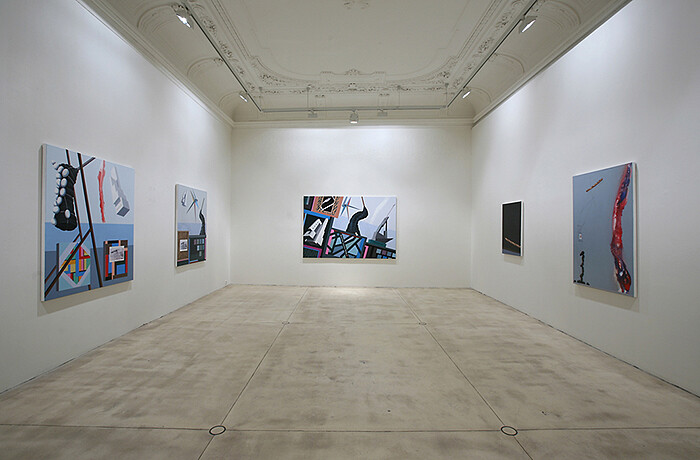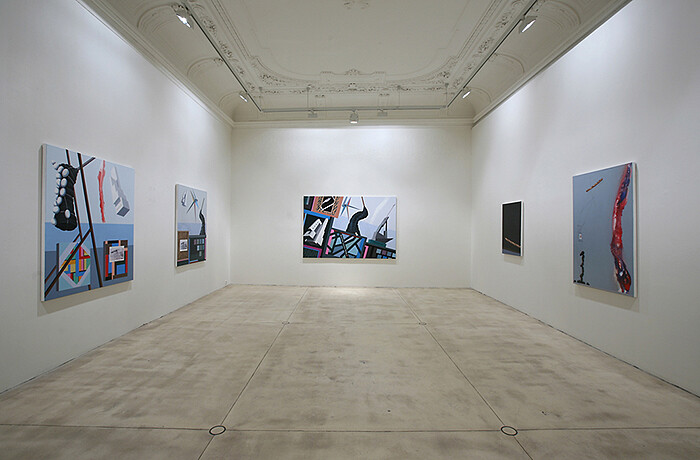Looking at Nader Ahriman’s paintings is somewhat analogous to reading Wittgenstein’s Tractatus or Pound’s Cantos; you need a guidebook to navigate the arcane references and codes. Nonetheless, his artistic gravitas grabs you immediately, pulling you into his very own dialectic apparatus. Mythological man-machine hybrids abound in theatrical mise en scènes hovering amidst geometric platforms, textual markers, and free-form associations.
Since the mid-1990s, Ahriman has consistently mined the grey areas of sociopolitical history, philosophical inquiry, and critical reasoning. A philosopher trapped in a painter’s body, Persian-born Ahriman exiled himself to Germany in the 1980s. As an outsider in a foreign land, he took solace in the traditions of 19th-century metaphysical philosophy of his adopted country.
For this sublime show very in line with the Viennese psyche, “Die Hegelmaschine trifft die Weltseele” (The Hegel Machine Meets the Soul of the World), Ahriman presents works created over the past seven years: watercolors, mixed-media collages, a series of inter-related paintings, and a single but important wall-mounted sculpture. The crux of the show is a new series of mixed-media drawings depicting Hegel’s 1806 encounter with Napoleon Bonaparte on horseback riding to a reconnaissance mission in Jena, a university town in central Germany that the French had occupied. Appropriated from an 1895 Harper’s illustration, the drawings repeat various versions of Die Hegelmaschine.
In one picture (all are titled Die Hegelmaschine trifft die Weltseele, 2011), Hegel doffs his cap to a passing Napoleon, with the manuscript for Phenomenology of the Spirit neatly wrapped in parcel and twine tucked under his arm. Hegel’s naked left leg is held off ground and has a baguette strapped to it (the nude leg suggesting the proverbial washing of the feet and the bread a recurring symbol of Christianity). Another watercolor represents Napoleon as a kind of low-tech tower machine on wooden stilts, with Hegel giving the same salutation fully attired, feet firmly on the ground. The next image is of Hegel as a constructivist-shaped form with an upside-down cross and some real ivy collaged below suggesting an adorning wreath. Yet another one has them encountering each other as machine/sculpture hybrids, Hegel alighted by epiphanic fire.
Intrigue awaits in either of the two regally appointed main galleries where the Berlin-based painter’s visual style and atmosphere alludes to more than just figurative quotations of de Chirico, Ernst, Picabia, and Oskar Schlemmer. Rather Ahriman subconsciously expands upon their works. Bodies levitate or are static drones (not unlike the figures of Neo Rauch); they are performers positioned as chess pieces in geometric diagonals, grids, and platforms derived from a Modernist vocabulary.
With their allegorical titles, the paintings offer up a key to the psyche of the artist. Replete with contradictions, mirrors, and opposites, his dueling pictures face-off with multiple perspectives of the same situation. Among them is the series of paintings titled “Die Gegenständlichkeit der Gegenstände,” 2008 (which translates to “The Concreteness of Objects”). The appeal of Malevich’s void encounters the pulsating color of Abstract Expressionism, Jackson Pollock’s angst, and the articulation of an absolute. Further imagery consists of a monumental sculpture set atop a wilting pedestal references Adolf Loos’s unadorned design aesthetic with antiquity. Juxtaposing Buster Keaton’s head on the limbless body of the Venus de Milo, the sculpture is graced with a dose of ironic humor. A Gothic-shaped pediment with the chiseled inscription “Gegenstand” (the object) completes the trio of body, material, and metaphor.
Buster Keaton is just one of numerous recurring off-kilter characters appearing in Nader’s paintings, including Sarah Bernhardt, Ezra Pound, Socrates, Plato, Nietzsche, Rimbaud, and Paul Verlaine. Ahriman seems to identify with these anti-heroes but the effect is more than that of identification; rather, he creates a literary conversation with the historical avant-garde. By systematically playing opposites with conscious analytical precision, a logical dénouement is not the point being made here. With the indecision of Hamlet, his lucid inconclusiveness is a choreographed performance.
Oscar Wilde once commented that “the true artist is known by the use he makes of what he annexes, and he annexes everything.” In the era of re-appropriation and YouTube cut-ups, Nader Ahriman annexes and then synthesizes philosophical ideas with a painter’s sense of art history. With a suspension of disbelief, you’ll find an originality that is uniquely his own 21st century Romanticism. The lone wall-mounted sculptural work (which also recurs as an image in many of his pictures) resembles a hybrid Franz West passstücke and a broken arm cast. In lieu of the hand and fingers are paintbrushes, the tools for which to produce the alchemy of the philosopher’s stone.






